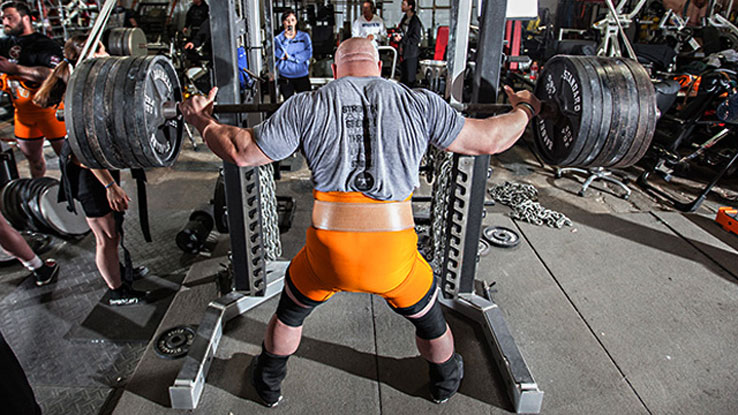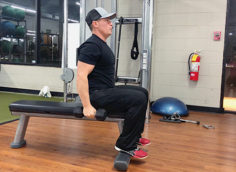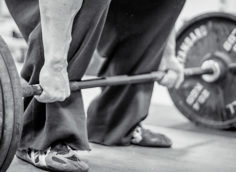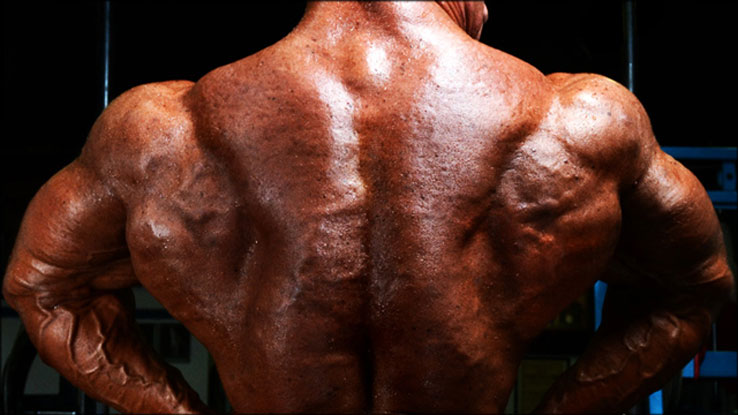When your squat stalls, everything comes into question – from the obvious things like setup, technique, and programming – to the more deep-seated factors, like whether you're just too much of a pussy to move any real weight.
Squat plateaus have caused many strong lifters to stop competing, or quit powerlifting entirely. After all, you can still build a powerful looking body without ever entering a power rack. But you'll never really be strong – stronger than the average guy, sure, but not the type of strong you dreamed of becoming when you first set foot in a gym.
For that kind of strength, you need a heavy bar on your back. There's just no way around it.
Unfortunately, squats aren't the easiest movement in the world to do. To be perfectly frank, they can be hard as fuck. Even the most gifted squatter will at times look down at the puddle of puke between his legs and ask why the hell they're doing this to themselves. And when they pound away and don't get bigger or stronger – or worse, get injured – it's just a matter of time until they just stop doing them.
But that's not you, right?
First off, this article – and my expertise – is about building a stronger squat. It's not squatting for optimal leg development.
They are markedly different things and require entirely different approaches.
A bodybuilder squat is typically much narrower, more upright, and activates the quads through a much greater range of motion. It's all about tension, or isolating the quads while minimizing involvement of the lower back and glutes (to a degree).
On the other hand, a powerlifting squat is geared towards minimizing tension and just focusing on the movement. In powerlifting, whatever method or stance that allows you to move the most weight is the right stance for you.
It helps to think of it this way – one is all about muscle and the other is all about movement.
Many powerlifters make fun of the bodybuilder squat as it leaves a lot of weight on the table, but you have to remember that success leaves clues, and if a powerlifting squat built bigger quads, bodybuilders would certainly do them. They squat that way because it's the best for quad hypertrophy, period.
So if you're squatting to build bigger quads, this isn't the article you're looking for. If you want to get your squat bigger and stronger, read on.
Any sticking point can be attributed to one of three things:
- Mental
- Technical
- Physical
As a coach, the first thing I do is figure out which of the three is contributing most to the plateau, as this determines the path I take.
Note: These are all related and are not independent of each other, but separating them this way has proved to be the best way for me to diagnosis sticking points.

The mental barriers in squatting are the most difficult for powerlifters to overcome.
If you've ever squatted heavy in your life you'll know exactly what I'm talking about. You take the bar out and it feels like a ton. You struggle to stay upright and can barely adjust your feet.
The idea of squatting the weight down and getting back up is ridiculous. You'll get crushed, stapled like a loser at the bottom of the rack.
But then it happens. You draw in your air, sit back into the hole and feel your hamstrings and glutes tighten up before exploding back up, driving that "impossible" weight to the start position.
What you thought was impossible was anything but. That's overcoming a mental barrier.
To achieve the right squatting mindset, the first thing to realize is that squatting is a skill, like a javelin throw or a shot-put. You just can't saunter up to the rack and squat 500 pounds, just like you can't throw a shot put 20 meters your first day.
Proficiency requires expert coaching and a ton of practice. You have to strive to make every rep the same – as close to perfect as possible.
Ed Coan once was asked to describe the importance of walking the weight out, something most lifters don't even think about. Ed proceeded to show how he walks the weight out, using the bar, and it was very clear every step was exact and specific, something he's done the same way for over three decades.
There was no wasted energy or extra movement. While you may think this is technical or even physical, let me tell you it's mental discipline and focus.
Second, you have to get over your fear. It's fear that keeps most guys from achieving depth with heavy loads. That's why I love the box squat so much. It gives guys a target, so they don't feel like they're dropping into a bottomless hole they can't come back from.
The trick is to start with a high box and slowly drop it down as confidence grows. Also, always be mindful to never just drop on the box, get loose, or do any of the other dumb shit I see online all the time. The box is a tool – not a fucking springboard. Sit back, stay tight, and in control.
Another way to accomplish this is with the power rack. Simply setting the pins a couple inches below the bottom position can give lifters the peace of mind they need to take the weight all the way down without fear of getting stapled. Yet how often do you see guys actually use a rack properly?
Oh, and spotters – good spotters – also help.
A third mental issue is over or under-arousal. While not being ready for the lift is obviously a problem, being too amped up can be a huge energy leak, especially before you're under the bar.
I just think of Steve Goggins – he was always focused right until he had the bar on his back. Then all bets were off. In other words, he saved his energy to unleash it during the lift. If you've ever seen Steve lift in person, his entire mental state changes as soon as he grabs the bar.
Fourth are excuses. Every lifter with a shitty squat has a litany of excuses for why they suck so badly. I have no time for these people. If your squat sucks, offer your excuses to someone who cares – which is nobody.
And if you hate squatting, then don't squat! No one is forcing you to powerlift. Do something else, anything, and preferably far away from me. Do you seriously think anyone cares about your trick knee or back issues? Every lifter has issues to contend with so go see a doctor or shut the fuck up.
Finally, there's the simple fact that squatting is hard. There's no getting around it. A 10-15-rep set of squats will make you feel like your heart is going to explode, while a one-rep max can leave you seeing stars.
No magic mental tricks exist that suddenly make the lift feel easy. My advice is to just nut up and get under the bar.
Here's something I've never understood. Squatting is so problematic for so many lifters, yet everybody at some point wrestles with taking a stubborn shit on the toilet.
And what do they do? Fill their bellies with air, bear down, strain like hell, turn purple, and give it all they got. If this doesn't work they stay there until the job gets done. So most lifters work harder on the toilet than they do in the squat rack.
If all else fails, revert to how I handle the excuse makers: Do. Something. Else!

Squatting technique is a tricky topic as there are many different styles that can work.
First is the stance. I advocate a wide stance, but that doesn't mean it's the ideal style for every lifter. So your first order of business is to figure out the best stance and your anthropometry, injury history, and goals.
Here are some criteria:
- If you have shoulder issues, choose a medium to wide grip.
- If you have a short back, choose a medium to wide stance.
- If you have a long torso, choose a medium stance (the longer the torso, the closer the stance).
- If you have long legs and a long back, choose a close to medium stance.
- If you have long legs and a short back, congratulations. You can squat any way you want.
- If you're using gear, obviously a wider stance is best as the gear supports the hips.
The reason I like the wide squat so much is efficiency. It shortens the distance the bar has to travel to reach depth.
For example, when I first showed up at Westside, the average distance the bar had to travel for me to hit depth was 16 inches. After working with Louie Simmons for so many years, it was shortened to just 6 inches.
Simply widening my stance shaved 10 full inches off my range of motion, which is a big advantage when you have PR weight on your back.
Next, you have to do the right shit. A good squat should sound like this:
- Tight (From hands on the bar to feet on the floor.)
- Back arched
- Chest up
- Elbows under bar
- Upper back tight
- Belly full of air – breathe into you belly, not your chest. Look in the mirror – does you chest rise when you take a breath? If so, learn to pull that air into your belly. The reason is if you pull air into your chest, what happens when you breathe out? Your chest falls and the bar drifts forward.
- Grab the bar as close as possible without aggravating the biceps or shoulders. (Wider bars have led some to use a grip that impairs their ability to keep the upper back tight.)
- Load the hips first (hip hinge) and then break at the knees. This increases glute and hamstring involvement.
- Knees tracking in line with the angles.
Above all, be mindful of the path of the barbell. When viewed from the side, the barbell should drop straight down and come straight back up, like you'd dropped a plumb line.
This can occur with any stance and depends 100% on how the lifter is built. So if you're unsure whether your stance is right for you, start there.
However, it's very hard to go from a close stance to a wide stance. It can take upwards of two years to relearn the movement and develop the flexibility, especially if the lifter is very tight.
Many lifters will crap out and just return to their original stance, and I don't blame them. But if the plumb line test reveals they should be squatting wider, they'll never reach their potential if they don't change their ways.
Keep a close eye on your knees. Some forward movement is okay (I don't like it personally, but with a medium stance you can't avoid it), but it should never exceed mid-foot and your knees should never drift in, unless you want to blow an ACL or quad tendon.
Also, remember that when your knee moves forward it lengthens the distance to hit parallel. The most extreme example of this is a sissy squat – at the bottom position your knees are almost on the floor. You're low as hell but not even close to parallel.
So what you give up with forward knee movement you have to make up with strength, or your technique trade-off is hurting your squat more than helping it.
Don't get me wrong, I like the close stance, Olympic-style squat. I think it's a great looking squat, and I know a lot of very strong men who squat that way. Here's the thing – the guys that it works for, it works because it's the right squat for them!
The majority of powerlifters who would be far stronger if they went wider and stopped pretending they were late cuts from the Chinese Olympic lifting team.

I've never seen a "perfect" squat. There's always something that could be improved upon. I worked out with Chuck Vogelpohl for 14 years – arguably one of the top squatters in the world – and there wasn't one workout where we didn't have to yell at him to keep his chest up, head back, or some other cue.
Heavy weight has a way of humbling all mental, physical, and technical attributes of the squat. There needs to be reinforcement. There needs to be coaching.
This speaks to the importance of proper cueing. You have to be in each other's ear with the verbal cues throughout the lift, especially as the weight gets heavy and the fight or flight hormones kick in.
Sometimes you have to say something 15 times or more before the lifter hears it, so it's smart to get in the habit of cueing throughout the lift.
To that end, here's what everyone's been waiting for, the "what exercises should I do when my squat looks like this" section. Even though 90% of the time the issue is poor technique or choice of stance, lifters still think that there's some magical assistance lift they're not doing that's preventing them from being a world champion. Fantasy land, I know. All right, I'll indulge you.
If you fall forward. The big thing is to simply perform the lift correctly.
Chest up, knees out, big air, belly tight, tight grip, and spread the floor. This eliminates many problems right away.
Failing that, falling forward is typically due to weak abs and lower back.
My favorite exercise for this is the hanging leg raise, performed with straight legs and kicking the bar at the top. Be sure not to extend backwards more than 6 inches – keep the tension on the abs.
If these are too hard then bend at the knees and pull up as high as you can. Use elbow straps if grip is the limiting factor.
Another good move is the pulldown ab crunch. Attach a triceps attachment to the lat pulldown station and stand facing away from the unit. Pull the rope taught and hold it under your chin.
Do not press your ass against the machine – keep the tension in your abs. Contract your abs and bend at the waist, pulling air into your diaphragm as you go down. This greatly improves stability during the squat while also strengthening the hip flexors.
For the lower back, hyperextensions and reverse hyperextensions both work well.
If you get stuck in the bottom. Here's a thought – before you angst over the right magical assistance lift, maybe the weight is just too fucking heavy.
While painfully obvious, you'd be amazed at how many lifters fail to consider this.
After that, often the problem is not sitting back far enough, and if in a medium or wider stance, not pushing back far enough (there's a difference). You need to elongate the hamstrings during the descent to create the stretch reflex. That's why the closer stance can feel stronger out of the hole – it creates a greater stretch reflex.
If you get stuck three-fourths of the way up. This is due to weak glutes and hips.
Here glute bridges, reverse hypers, and good mornings pay huge dividends, as does simply learning to flex your ass.
One trick I like is sitting on a box that's way below parallel with bands wrapped around my knees and holding it for 15 seconds. The bands should be tense enough that 15 seconds feels very hard.
This not only helps activate the glutes, it also helps build stability in the knees and hips, which is huge because a muscle must stabilize, then absorb force, and then create force – but only in that order.
If your knees buckle in. This leads back to the hips, glutes, and hip rotators.
The first thing is to reassess the stance, making sure it passes the plumb line test. Next is to reinforce basic cues like "spread the floor" and determine if flexibility is where it should be.
This can be a huge problem, so I'd reduce the training weight to a point where this won't happen and then reintroduce the loading as the weak points are overcome.
If the bar feels heavy. Step one is to grow a set of balls.
Seriously. Sometimes shit is heavy – that's why it's powerlifting. You want easy weights, go hop on a leg press, preferably the pin loaded version. That way you can pump out reps while you read the paper or update your Facebook page. Pussy.
Next is to strengthen your abs and your hip flexors and to focus on achieving maximum tightness from the get go. Too many guys wait until the bar is on the back before they get tight – that's already too late.
I like to see guys fill their belly with air and keep it while they find their stance, and then let it out gradually before pulling it back in with one big breath and holding it. It makes a huge difference – try it for yourself.

I'm not going to write out some new squat routine; the greatest routine in the world won't help you squat any better. So here's a framework for how you should approach every squat session.
Warm-up. Do whatever you feel you need to do to warm up. This should not be a freaking 20-minute sweat session. People are getting way too carried way with this shit.
Here's what I've noticed. If you have hip issues you're told to do a series of mobility movements. Okay, I get that if the issues are muscle or tendon related, but what if it's muscle activation or joint related?
If the muscle isn't being activated then working the movement won't do it. If that were the case it would be activating in the first place!
If it's joint related – the joint is bone-on-bone or losing space – the best way to worsen the issue is by moving it more. It's called wear and tear for a reason, so if the joint is bone-on-bone, how exactly will a couple hundred reps of extra movement to the joint help? Think about it.
My advice. If you're messed up go find a good doctor or physical therapist. Trust me, they're out there.
As far as specific warm up stuff:
Pulldown Abs. Yeah, do these before you squat. These stretch the torso, hips, and the abdominal region. Do 3-4 sets of 10-15 reps.
Glute-Ham Raise. Simply because most people absolutely suck at them. Do 3 sets and keep them all a few reps shy of failure.
Now it's time to squat. You're going to do a ton of warm-up sets. A good rule of thumb: if you're trying to reinforce your technique, double the number of warm-up sets you normally do.
You can't practice technique when the load is heavy, so it's during your warm-up sets that you lay the foundation for a good squat session. Don't screw this up.
Next, after the warm up, squat as prescribed – whatever protocol you're using.
After the squat, its time to hit the assistance work. Start with a supplemental lift that builds the squat, performed in the 3-5 rep range. Best choices include:
- Barbell Row
- Stiff Leg Deadlift
- Romanian Deadlift
- Good Morning
Work up to a couple work sets and swap out the movement every 3-4 weeks or when you can no longer make progress with it.
Next is hamstring work. Here you'll hit the glute ham raise first – because everyone sucks at them – and then another hamstring movement that hits them at either the origin or insertion, like leg curls and Romanian deadlifts. Bump up the reps to 8-12 for a few work sets.
Now it's more abdominal work. Hit hanging leg raises or pulldown abs. Cycle between the two every three weeks.
Finish off the day with lower back work. Reverse hyperextensions or back extensions, performed for high reps (at least 20).
The work continues even on non-squat days. Remember, technique trumps everything, and you'll never become a proficient squatter if you only work on the movement once or twice a week.
On your other days, I recommend performing squats with just a broomstick during your general warm-up. This helps reinforce sound technique by "greasing the groove," so good habits stay on top of mind.
It takes a ton of reps to master even a basic movement, and that much more when correcting a previously established motor pattern.
It all boils down to learning the lift correctly from the ground up. My hope is that you don't fall into the trap of trying to find some mystery exercise to take your squat into Elite status, and instead get brilliant at the basics.
Find the right stance for you, learn to sit back and hinge, and get those cues drilled into your subconscious. There is no shortcut to mastery.





